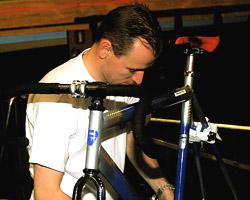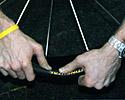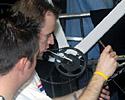
Recently on Cyclingnews.com |
Tech feature: Track-side mechanics, January 12, 2007
Early starts and late finishes

|
They're the first to arrive at the track and, despite all the partying that goes on at six day events, usually the last to leave. Cyclingnews' Laura Weislo gets walked through a day in the life of a track mechanic by Ken Ilegems at the Gent six day.
It's early afternoon, and the velodrome is nearly empty. The detritus of the previous night's partying has formed a layer of filthy ooze that covers the floor of Het Kuipke's infield. Standing in front of dozens of wheels, trying to keep his shoes from getting stuck to the beer-encrusted floor, is 28 year-old Ken Ilegems, mechanic for several of the six day riders. The groan of the air compressor echoes off the empty seats, but the air is surprisingly clean since smoking was banned from inside the track during the Gent six day.
Ilegems, formerly a team mechanic for the T-mobile professional road team, is carefully checking each tyre for cuts and wear, and then inflating them to 150 PSI. He started working as a mechanic at the six days back in 2000, wintering at the track along with his co-worker Erik Zabel. While some might find it difficult to get work in this small circle of riders and support staff, Ilegems was already 'in the family'. "I raced pretty much on the track myself, so it was almost natural that I would work there as a mechanic too," he explained.
Soon, he found that the road season was seriously affecting his social life, and he left his full time job wrenching for the T-mobile team in order to have more time to train and race his own bike, and to keep his girlfriend, whose bike he was fixing up in his spare time at the track, happy. "Being away for 250 days a year wasn't a good thing, so I was looking for something that would keep me in cycling, but also more at home." So now, during the winter, he freelances for the sixes, taking care of star Belgian Iljo Keisse while wearing the T-shirt of his own wrenching business which he just started, called "Illi-bikes".
"On the small tracks they have real, real hard pressure on the saddle, and you can't afford to have the seatpost slip."- Track mechanic Ken Ilegems explains why carbon seat-posts are rare |
Now that he has more time to train, Ken has gotten back to doing something he's wanted to do for a while - race his bike. A pretty keen road rider, Ilegems signed for the UCI European continental team, Palmans-Collstrop. "My goals for 2007 are not that high, I would like to have a decent year with decent results, maybe a win in a kermesse race... and hope that satisfies my new team."
It's possible to continue to train for the road season while working the six day season, but takes discipline. For most of the out of town sixes, he can squeeze in a couple hours on the velodrome before he gets to work, but during the Gent six day, he spent those precious idle hours commuting from Het Kuipke back to his home near Antwerp.

|
His day starts around 2pm, when Ilegems arrives at the velodrome and unlocks all of the bikes, wheels and tool chests and gets to work. The riders put their equipment to the test during the sixes, riding well over 100 kilometres per night on steep tracks like the one in Gent. In the turns, riders can experience up to 1.5 times the force of gravity, and behind the derny they can go as fast as 70 km/h, so perfectly functioning equipment is essential.
Each rider is responsible for hiring their own mechanic, but they normally choose between a handful of guys who work the sixes every year and are contracted by the race organizers. The mechanics are not your average shop wrenches - to prepare bikes for such demanding conditions takes a lot of skill that comes from years of experience, and the riders choose only the best. One of the other mechanics in Gent, Kenneth Van de Wiele, worked for Rabobank last year, and is now with Team CSC.
During the afternoon, Ilegems will wash and polish the bikes and wheels, glue on tires, lube chains and check all of the parts on the bike carefully to make sure nothing has come loose or cracked. It's not unusual for parts to break. "In this box is a saddle that broke in Munich", says Ilegems, showing me a very worn saddle with alarming cracks in its rails. The extreme pressure the rider experienced in the turns eventually split the rails at the end of the seatpost clamp.

|
You won't see many lightweight carbon components at a six day. Weight offers little disadvantage to the riders, and the chance of breakage is higher, so things like seatposts, stems and bars are heavy-duty. "You won't see many carbon seatposts - you can't tighten [the clamp] down on carbon like a you can a normal seatpost. On the small tracks they have real, real hard pressure on the saddle, and you can't afford to have the seatpost slip."
Even the bike frames have to be fairly heavy duty. While there are a few riders on carbon bikes, the material hasn't become as prevalent in the six days as it has on the road. Most of the riders opt for a custom aluminium frame with a carbon fork. Strength and stiffness, especially in the bottom bracket area, are important for a frame, as are aerodynamics, so most riders have a bladed downtube, at the very least, but most bikes are fairly basic. However, several riders, such as Swiss riders Alexander Aeschbach and Franco Marvulli, are riding special high-tech carbon bikes with very narrow bottom brackets and rear hubs with proprietary cranksets.
Perhaps the most important part of the bike is the wheels, and riders come with no shortage of wheels and tyres. "Most riders have four or five pairs of wheels. During a six, they'll go through two or three sets of tyres if they don't flat." All of the riders use tubular tyres, and even those get special treatment. "Normal glue won't hold. The sideways pressure in the turns will roll the tire right off, so we use special glue". Ilegems wouldn't say exactly what product he uses, but said that it is an automobile adhesive, while other mechanics have used carpet glue. One thing is for sure, you don't want to be the one who gets a poorly glued tyre!

|
One thing that has remained the same for years is that the six day riders are all still using 1/8" equipment, despite some trackies heading towards the more standard 3/32" width for chains, cogs, and chainrings.
So how many riders can one mechanic deal with? "One mechanic can take care of up to five riders," says Ilegems. Each rider has normally two bikes but there are some riders who prefer to bring more. "The most I had to deal with is four [bikes]. Matthe Pronk brings four. It's easy for me - usually you have to change the gears for each event: between the Derny race, lap record, or time trial - he has a bike for everything, so I just have to hand him the right bike at the right time."

|
Once the bikes are prepped, all of the tyres glued on the wheels and inflated to the proper pressure, the mechanics get a break for dinner before the racers take to the track at around 8 PM. Once the racing starts, they're busy swapping gears and taking care of the riders. While most of the six days have long intermissions in the racing, with concerts and other entertainment for the crowds, Ilegems said: "Gent is one of the most demanding races, because there aren't very many breaks between events. The longest break is maybe 20 minutes."
With breaks that short, and seemingly scheduled so that a gear change is necessary for every event, it's a good thing Ilegems can swap gears almost as fast as a derailleur. The opening mass-start races, where a 52-16 is the most common gear for the Gent track, are followed by the Derny races, where riders will don the massive gear of 54-14 - one so big that riders need a push from their crew just to get onto the track. Next is the time trial, where a 52-15 is needed, then it's back to the mass-start gear.
After the last race has run, and the riders are heading home, the mechanic's night isn't done. They must pack up all the gear, lock down all the bikes and tools, and then, finally, head home or to the hotel to get a few hours of much deserved rest. When the racing wraps up as late as 2am, it's not surprising there are a few cans of energy drinks left lying on the floor amongst the smashed beer cups left by the fans.
Photography
For a thumbnail gallery of these images, click here
Images by Emory Ball/Cyclingnews.com
- Ilegems makes some time to work on his girlfriend's bike.
- Ken Ilegems applies his secret glue to the rim.
- Ken Ilegems demonstrates proper tyre application technique.
- Gluing tyres takes up a fair bit of a six day mechanic's time, as Ken Ilegems shows.
- The track bag contains all the chainrings, cogs and other gear the rider may need.
- Franco Marvulli's bike is skinny!
- Ken Ilegems talks about a mechanic's life.
- Illi-Bikes is Ken Ilegems' new business

